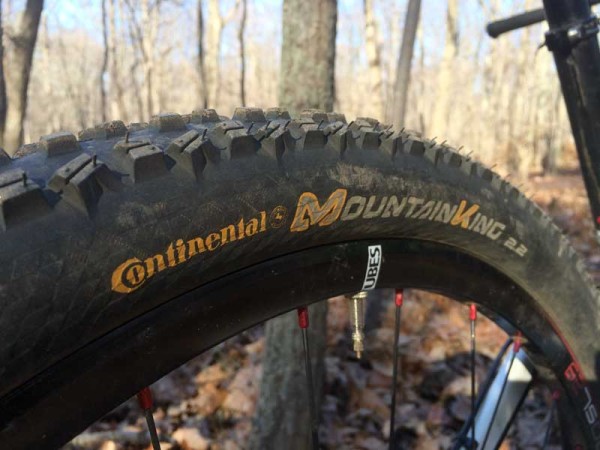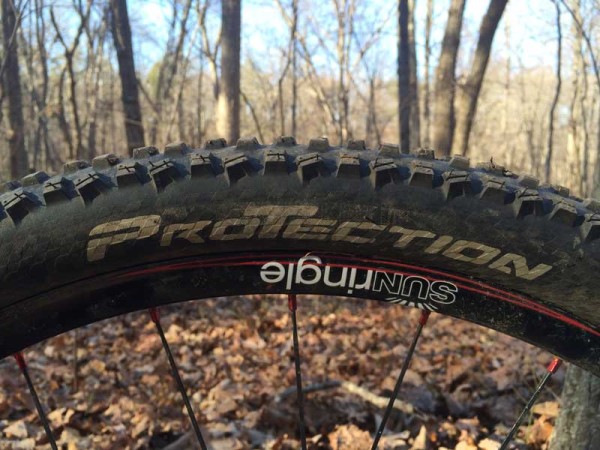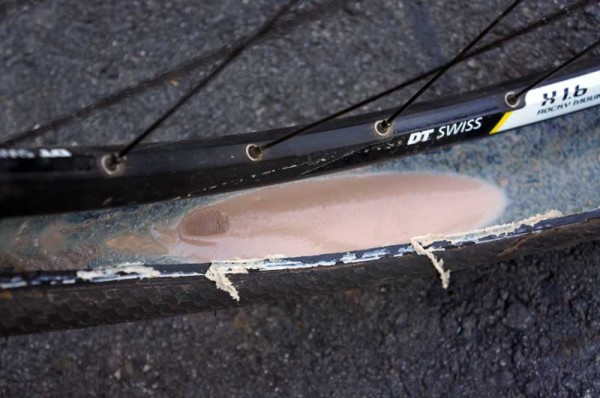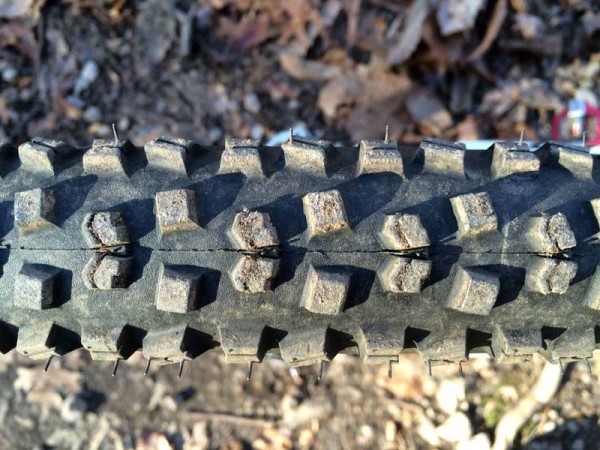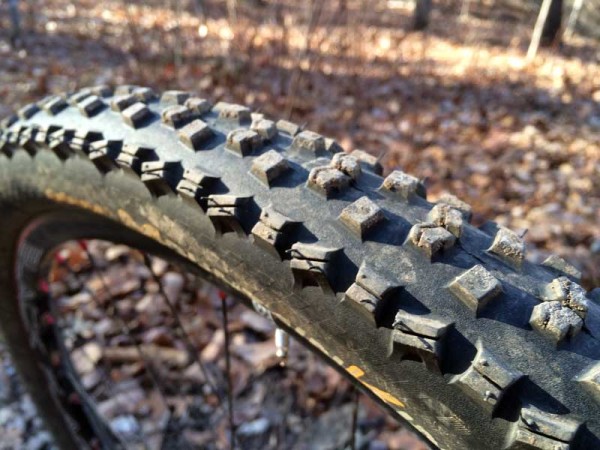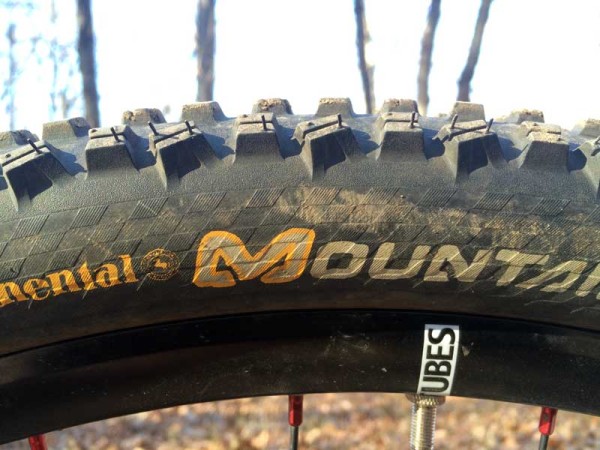After a bit of a confusing kick off to their tubeless ready offerings in 2012, Continental’s been steadily expanding the options across their entire range. That’s not to say the naming scheme is any better, unfortunately. Tires are offered in a variety of casing options, including a proper UST, the tubeless ready “Protection” versions, and everything else that’s not officially tubeless. That includes their “Protection Apex” models, which will see more options later in 2015. But that’s getting ahead of ourselves.
Considering the performance of the Mountain King, though, those naming issues can be forgiven. When the leaves became too much for the lower profile X-King or Race King tires (or similarly hardpacked summery tires from other brands), I mounted the Mountain King Revolution tires last fall. Yes, that’s fall of 2013. They immediately provided the grip needed on our autumn leaf covered trails and carried themselves well all through the winter, too. They were so good, I kept them on all summer and have been spending more time on them again now that we’re in the midst of another winter.
But grip is only part of the story. There’s some interesting character traits worth considering…
UPDATED: Widths measurements added.
First things first, the weigh in: My 29 x 2.2 Mountain King Protection tires came in at 708g and 750g. Not superlight, but respectable for a big knobbed aggressive all-mountain tire.
Now, back to the casing. To make their tires “tubeless ready”, Continental uses a UST-style bead and an additional protection ply running from bead to bead. Not only does this make for a tougher tire all the way around, but that layer creates a bigger barrier to air permeation. It’s not the same as the butyl liner that makes UST models airtight, but by definition “tubeless ready” requires sealant to hold air.
Side note: Continental’s rep Brett Hahn says UST will not be sold in North America in 2015 and beyond due to lack of demand.
REVO SEALANT
To test their tubeless readiness, I started out with Continental’s Revo Sealant. I actually tried the sealant several times before putting it in the MKs reviewed here. The pic above shows it on the Rocky Mountain Element 29er’s Race King tires…which we struggled to get it to hold air well and it ended up pooling and thickening into a glob.
After trying it on several other tires, various rims and tapes and multiple configurations, I ended up with a set of Sun-Ringle Black Flag wheels to test and brand new bottles of Revo Sealant and new Mountain King Protection tires. So, brand new everything that would be part of creating a tubeless system, and the Sun-Ringle wheels use Stan’s NoTubes licensed rim profiles and had factory installed brand new Stan’s NoTubes tape. If ever there were a perfect setup for perfect performance, this should be it. Sadly, I still had trouble getting the sealant to work well. It didn’t pool up quite as bad as the pic above, but it just didn’t seem to hold air for very long, necessitating mid-ride fill ups.
As much as I love Brett and Conti’s PR folks, I simply can’t recommend the sealant when others work much better for me. Conti does not recommend mixing it with Stan’s sealant because the respective ingredients won’t play nice, but I’ve added Orange Seal to the tire and seen immediately better results. Not perfect, mind you, but I think that’s better explained as part of the tire review…
MOUNTAIN KING PROTECTION
UPDATE: As the commenters have noted, yes, these run a bit narrower than the 2.2 moniker implies. Mounted to a Sun-Ringle Black Flag Pro SL rim (24mm outside width), they measured a hair over 2″ wide at the widest part of the casing. The side knobs spread to about 2.1″.
Since the casing relies on a coated nylon fabric to reduce permeability, there’s no claim to it being airtight. That’s the case with any tubeless-ready tire, so no complaints there. But, compared to other tubeless-ready tires I’ve used, these seem to be a bit more porous. Or, at least more prone to air leakage. I quantify this in two ways: One, they lost air more quickly than others I’ve used. Two, the sealant (any sealant, not just Revo) inside seemed to dry up more quickly than in other tires.
With more frequent sealant injections, they’re fine, though, and here’s why I’m OK with that: Because these tires rip!
The knobs are tall and big, so they bite into everything. They’re widely spaced, so they shed muck and mud quickly. And they’re made of Continental’s premium Black Chili rubber compound, so they’re grippy on the harder stuff, too. It’s a great combo of four season, all conditions performance that proves a few more grams of rotational weight are more than made up for by the additional cornering speed afforded by the traction.
The side knobs are closely packed, which means continuous grip in the corners. While there’s open space between them and center knobs, there’s no odd transition from straight to cornering. For me, that added a lot of confidence on all levels of turns, especially those with changing radii from the entrance to the exit. Or just whipping the bike about on loose or uneven terrain. They are a bit noisy on ultrahard pack or when riding the road to the trail, but for anything else, they seemed efficient enough. Braking is solid and predictable, too.
The upside to the deflation issues I had was that the tire was routinely (um, very routinely) run at diminishing pressures. That’s an upside only because it meant harsher testing conditions. On more than one ride I simply tired of pumping it up and let it get hit-the-rim low before stopping each time. That put the sidewalls under a lot of compression and bending, twisting and folding forces, and this is what they look like after many months of riding…pretty dang good.
The Protection casing is a comparatively rigid casing, adding a lot of support to the sidewall. When fully deflated, it can retain it’s generally round shape on a lightweight bike, not giving away its flatness until you start rolling it outta the garage. I initially thought this might detract from its suppleness, and it probably does a bit, but on the trail with adequately low pressures, it still hugged all the nooks and crannies. Honestly, I didn’t notice any undue harshness from the casing.
What I did notice was the lack of wear and tear on the sidewall. I had no tears, rips or other issues during the past 16 months of testing. Considering how much these tires were ridden in an ultra low or near flat condition, the minimal thread showing now is impressive.
Keeping in mind I’m often testing several tires and complete bikes at a time and no one set of tires gets 100% of my miles at any given time, tread wear has been very impressive. My terrain is mostly hard-ish packed clay and dirt, lots of roots and some rocks (more rocks when riding in Asheville/Pisgah). I haven’t been shearing them across Moab-style rockscapes. So far, all knobs are present and accounted for and in good condition. I had a chance to ride these out west on California’s dry, packed orange dirt and it took me a bit to get used to, but they worked pretty well. It could just be what I’m used to, but these felt better on typical East Coast terrain.
Big picture: Continental’s Mountain King Protection tires are a superb all-around ripper available in 2.2 and 2.4 widths and all three tire diameters. If you don’t mind adding sealant a little more frequently, these should last you a good long time and, by providing killer traction, help you last a good long time.
